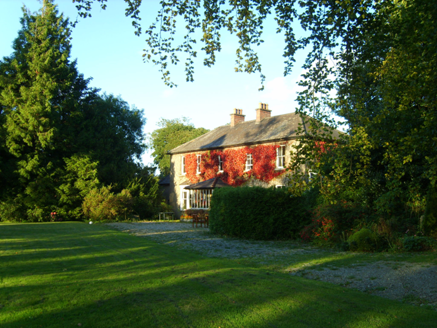Survey Data
Reg No
15703004
Rating
Regional
Categories of Special Interest
Architectural, Artistic, Historical, Social
Original Use
Farm house
In Use As
Farm house
Date
1760 - 1765
Coordinates
277741, 129686
Date Recorded
10/09/2007
Date Updated
--/--/--
Description
Detached five-bay two-storey farmhouse, dated 1764, on a T-shaped plan originally three-bay two-storey on a rectangular plan centred on single-bay single-storey projecting glazed porch to ground floor. Occupied, 1911. Extended, 1919, producing present composition. Hipped slate roof with clay ridge tiles, paired red brick Running bond central chimney stacks having stringcourses below capping supporting terracotta tapered pots, and cast-iron rainwater goods on timber eaves boards on rendered slate flagged eaves retaining cast-iron octagonal or ogee hoppers and downpipes. Creeper- or ivy-covered roughcast walls. Square-headed central door opening into farmhouse with cut-granite lugged surround centred on fluted keystone. Square-headed window openings with cut-granite sills, and concealed dressings framing two-over-two timber sash windows having part exposed sash boxes. Interior including (ground floor): central hall retaining carved timber surrounds to door openings framing timber panelled doors; and carved timber surrounds to door openings to remainder framing timber panelled doors with timber panelled shutters to window openings. Set in landscaped grounds with cut-granite monolithic piers to perimeter.
Appraisal
A farmhouse representing an integral component of the mid eighteenth-century domestic built heritage of County Wexford with the architectural value of the composition suggested by such attributes as the rectilinear plan form centred on a Classically-detailed doorcase demonstrating good quality workmanship, albeit one largely concealed behind a later porch; and the diminishing in scale of the openings on each floor producing a graduated visual impression: meanwhile, aspects of the composition clearly illustrate the continued development or "improvement" of the farmhouse in the early twentieth century. Having been well maintained, the elementary form and massing survive intact together with substantial quantities of the original fabric, both to the exterior and to the interior, thus upholding the character or integrity of the composition. Furthermore, a "cow tail" waterpump (extant 1922); and adjacent outbuildings (extant 1840), all continue to contribute positively to the group and setting values of a neat self-contained ensemble having long standing connections with the Thorpe family including William "Willie" Thorpe (----), 'Farmer' (NA 1911).

